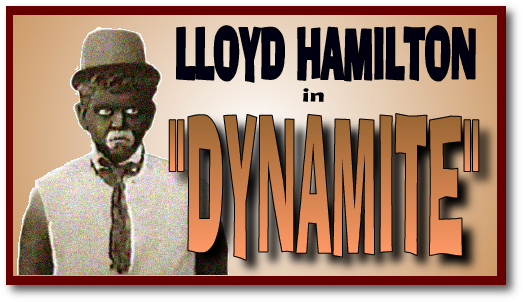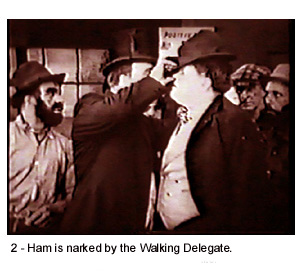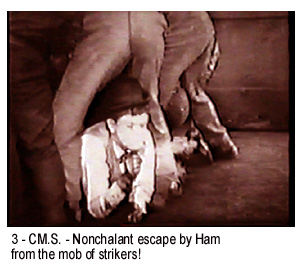

"Dynamite" is a typical product of the 1920 American Comedy Studios. The style set in 1916-17 by Chaplin, Arbuckle and Lloyd was fully established, and one and two-reelers were being turned out in large quantities. Prominent among the stars of these excellent comedies were Buster Keaton, Larry Semon, Ben Turpin, and, of course, the casual Lloyd Hamilton who is here under discussion.
Hamilton was born in 1891 and entered films in 1914 after considerable stage experience. He was a well-established star of two-reelers by 1920 and continued making shorts for Educational well into the talkie period, "Honk Your Horn" (1931) being one of the later gems. He only made four full-length comedies, none of which was outstanding - the best-known being "A Self-Made Failure" for First National (1924) and produced by J. K. McDonald and directed by Wm. Beaudine.
It is difficult to assess the responsibility for the various
production phases in these comedies, but it can be safely assumed
that the leading man, who was invariably surrounded by the same
gang of supporting players throughout a whole series, did much
towards the story construction and the supplying of new gags and
action best suited to his style of comedy. Hamilton worked to
a standard formula of burlesque stories laced with gags through
which he wandered with devastating results. His particular flair
and specialty was a form of detachment from the main issue of
the  story, coupled with sublime understatements
and/or remarks diametrically opposed to those expected - generally
expressed in crisp, well-worded titles.
story, coupled with sublime understatements
and/or remarks diametrically opposed to those expected - generally
expressed in crisp, well-worded titles.
The story of "Dynamite" is neither subtle nor profound. Trouble is stirred up at a munitions factory by a Walking Delegate.
The Manager refuses the Delegate's terms to settle this trouble. Ham comes in and is offered a job as a new foreman. In spite of friction with the Delegate, he takes the job. The strikers hear of the marvelous new formula and blow up the manager's safe, but Ham has the formula and, so, has to be chased. Meanwhile, the Delegate fixes a neat time bomb to blow up the manager and his daughter. Ham eludes the chasers and flings away the bomb in the nick of time.
This framework, for which it is unlikely that any originality would be claimed, allows a good measure of comic stuff in the "munitions factory" where dynamite and TNT are injudiciously flung around. The other routine ingredients - villain, professor's daughter, mob, and chase - are also properly catered for.
The film opens with one of those inspired titles that are
a never-ending source of joy to the student of cinema.
TITLE "Owing to International Complications, the Hades Munitions
Factory was working at full pressure."
L.S. (iris-in) Exterior of Hades Powder Works. MIX TO . . .
L.S. Man addressing two clients.
TITLE "Professor Ben Zeen was in conference with important
Clients."
CM.S. He says enthusiastically . . .
TITLE "Gentlemen, the formula is a success; I expect great
things from my new powder."
This opening, though over-titled, is a slick introduction, and the formula mentioned in (f) gives promise of a chase to come.
The action next shifts to a long shot in the factory where explosives are being manhandled by a weird gang of workers. The set is covered with a medley of notices - "TNT Powder," "Positively No Smoking," etc. Through a door, with the burlesque-villain-slouch, enters the top-hatted Walking Delegate. He plants the seeds of unrest, and the gang, therefore, deluges the Professor with a petition. The titles here are forced but redeemed when the Delegate enters, disperses the clamouring gang, and turns to the Professor with the remark, "99 percent of your business and your daughter's hand, and I'll stop the strike." This is badly received by the Professor and his daughter, and the Delegate strides away, thwarted, his hands clutching at air.
Then Ham appears on the scene and is offered a job as foreman "with good prospects of a high position." He wanders into the factory, casually tosses up a shell, and as the smoke clears away, is revealed with black face and fewer clothes but (a nice touch) still clutching his traveling bag. (Still No. 1).
Ham's first appearance as "foreman" is well arranged.
a. L.S. Ham enters.
b. L.S. Walks past gang and Delegate but latter grabs him, flings
him down, and picks him up. Ham remarks . . .
 c. TITLE "I am the new foreman."
c. TITLE "I am the new foreman."
d. L.S. (as b) Delegate knocks him down; gang pick him up, restore
his hat - he says . . .
e. TITLE "Why spoil my whole day?"
f. C.S. Delegate does the hat-nose gag (see Still No. 2) and walks
away.
g. L.S. (as b) Ham flings down hat and jacket and strides . .
.
h. M.S. . . . up to the Delegate who turns - so Ham strides .
. .
i. L.S. (as b) . . . back and borrows a hammer and tiptoes . .
.
j. M.S. (as h) . . . up to the Delegate, but has to hand over
hammer - he receives the blow himself, totters . . .
k. L.S. (as b) . . . back and collapses among the gang and . .
.
l. C.S. . . . stares at . . .
m. L.S. . . . five ghostly Delegates laughing at him.
n. C.S. (as l) He stares.
o. M.S. (as h) Delegate whips off jacket and advances . . .
p. L.S. (as b) . . . disperses gang, sets to work on Ham, bashes
him on floor and flings him . . .
q. M.S. (as h) . . . away.
r. L.S. he lands up with the Professor and . . .
s. M.S. . . . shakes his hand and remarks . . .
t. TITLE "This is a nice place. I like it."
This crisply cut and well-constructed sequence is the best in the film and is full of interest. The insults (b) and (d) with absurd responses (c) and (e) are grandly comic - the titles making excellent counterpoint to the action (h) and (j) are repetition effects, the second being the stronger, of textbook perfection. (g) and (o) compare the jacket flinging of the two diverse personalities. (l-n) is a fine close-up. And what Ham sees, in (m) is a grand pictorial exaggeration of "seeing double." In the middle of (p), a dummy is substituted for Ham, the effect being spoiled by about four frames too many being left at the beginning of the dummy shot. (q) shows the dummy flying towards the doorway, and in (r) Hamilton dives through the door and does an excellent somersault to land in front of the Professor - being only partly assisted by shooting at about eight frames per second. Title (t) caps a delightful chunk of comedy.
Ham is left with Christine, introduced by a superimposed title, which is foreign to the style of these comedies, whose producers were too cinematically minded to make use of this tempo-destroying and reality-shattering horror. Meanwhile, a chicken enters the factory and pecks up some powder, then lays an egg, which drops on a workman's bald pate and explodes. Ham enters, stoops over a dynamite box, and a second egg drops and explodes on his beam, startling him. A third egg explodes behind him. He catches the fourth, tosses it away. It explodes, startling him still more. These four effects gain force by repetition. Then Ham grabs the chicken and throws it out. It explodes, evoking his comment, "She must have been a Plymouth Rocket." A cloud of white feathers then falls over him, whereas the chicken was a Red. This seems to be a gentle leg-pull at anyone who challenged the title. (Note: These superimposed titles were a feature of a minority of 9.5mm releases and would not have appeared in the original version.)
A simple mid-shot and title explain the gang's intention to steal the formula. Meanwhile, Ham drinks a spot of TNT with the result of an explosion at every spit (which seems fundamentally hygienic).
Next, very explicitly, the safe is blown open. In M.S. the
gang set the charges - detail C.S. shows the fuse sizzling - in
L.S. the flame runs around the door - and in M.S. papers come
flying out.  These shots are really
brisk and lively. The gang dashes in and enters the safe. The
Professor and Christine enter, and with glorious stupidity, get
the formula from its real hiding place (another absurd superimposed
explanatory title ruins the detail shot) in nice time for the
gang to turn and spot them. (Note: Once again, these superimposed
titles were a feature of a minority of 9.5mm releases and would
not have appeared in the original version.)
These shots are really
brisk and lively. The gang dashes in and enters the safe. The
Professor and Christine enter, and with glorious stupidity, get
the formula from its real hiding place (another absurd superimposed
explanatory title ruins the detail shot) in nice time for the
gang to turn and spot them. (Note: Once again, these superimposed
titles were a feature of a minority of 9.5mm releases and would
not have appeared in the original version.)
They dash away but are cornered in the factory, so Christine pops the formula into a huge box. All disperse, the box lid rises, and Ham emerges. As he stands looking at the formula, he is, of course, seen, and the chase starts. There is a certain sublime wit in Ham's presence in the box.
The Professor and Christine are being tied up when Ham, chased, bursts in and hides in a crate - which, of course, is immediately taken away and turns out to be bottomless, leaving Ham exposed (it's that gag again). The gang all begin bashing him, but he crawls out, nonchalantly lights up (see Still No. 3) calls, "Couee!" (Title). Then he pushes the whole bashing bunch over and scrams. In long shot, he make for a fire escape and climbs up. Hotly pursued in a long shot panning vertically from the first to the eighth floor, they all sprint up, Ham reaching the roof with a fair lead. Half-speed assists this hefty climb. Meanwhile, with fitting gesticulation, the Delegate sets the time bomb. (Title) "Mark me, and mark me well, at 5 o'clock you will be in . . . . well - use your own judgment."
The gang chases Ham over the rooftops and, to dodge them,
he scales the parapet and hangs from a rope suspended between
two skyscrapers - in which awkward position I. Doubleyou (I
Doubleyou is a play on the IWWs, Industrial Workers of the World,
otherwise known as "I Won't Work.") spots him from
the roadway far below. Then, succinctly. . .
a. M.S. Delegate whips out revolver and fires.
b. C.S. Ham screams in horror.
c. C.S. (fringed) The rope cut through by bullets.
d. L.S. Ham swings on a downward arc . . .
e. M.S. . . . swings up to a wall and . . .
f. L.S. . . . through wall, amid a cascade of bricks to where
Professor and Christine are tied up.
g. CM.S. He (still with bowler) realizes the difficult position,
and . . .
h. L.S. (as f) . . . goes to release them.
i. C.S. Time bomb clock just on 5 o'clock.
j. L.S. (as h) Ham yells, flings away bomb, it explodes, screen
filled with smoke.
Here ends the 9.5mm version. Actually, Ham was blown to the top of telegraph pole, and thus attained the high position predicted earlier.
As in the shot of the fuse, shot (c) above is masked for emphasis. (d) has an indistinguishable dummy Ham. The (d)-(e) cut is perfect. (f) is a case of the use of balsa wood bricks. The bowler "in situ" in (g) is a grand touch. Altogether, a grandly cinematic final sequence to an excellent comedy.
Special Thanks
. . . to Dave and Ali Stevenson of Looser Than Loose Publishing for providing a copy of "Dynamite" from which the stills for this article were taken. Looser Than Loose Publishing offers a five-disc set called "Ham": The Lost Magic of Lloyd Hamilton. Visit their Lloyd Hamilton page at http://www.looserthanloose.com/LloydHamilton.html or contact them at info@looserthanloose.com.
Also special thanks to Dave Wyatt for supplying additional credits.